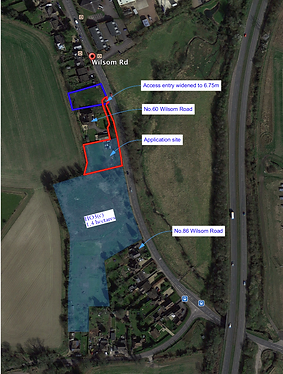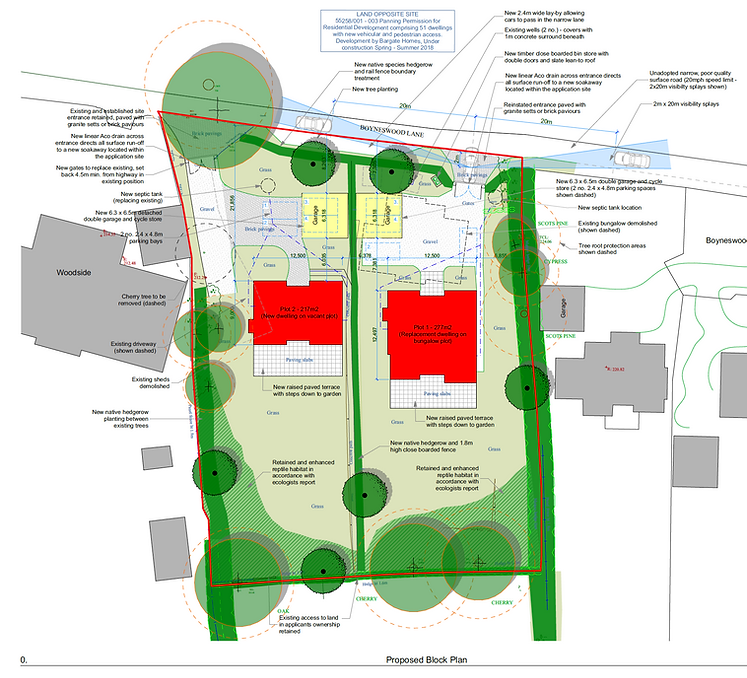
News
EHDC grants Outline Planning Permission for nine dwellings in Alton, Hampshire.
March 19, 2020
EHDC have granted Outine Planning Permission for nine new-build residential dwellings on land between No. 60-86 Wilsom Road, Alton. Ref: 55638/001. Voller Urban Design had previously promoted the land for inclusion in the Strategic Land Availability Assessment and subsequent allocations, resulting in the lands inclusion in the Alton Neighbourhood Plan, published in Spring 2016. An Outline application was made in Autumn 2019, initially for 23 dwellings in accordance with the allocation, however density was deemed too high for the semi-rural location and as a result the site area and housing quantum was reduced to 9 dwellings.

EHDC Planning Committee grants Full Planning Permission for two dwellings in Four Marks, Hampshire.
October 4, 2018
EHDC Planning Committee have granted Full Planning Permission for two new build residential dwellings on land at 'Merrow Down', Boyneswood Lane, Alton Ref: 29096/002. A similar VU application for outline permission (Ref: 29096/001) approved at Committee and granted in March 2015, had previously established the right to develop the greenfield land for two new dwellings. The full application sought to change the access arrangements whilst seeking approval of all outstanding reserved matters.
Court backs government plans to exempt small sites from affordable homes obligations.
May 11, 2016
The government has won a legal challenge against a High Court ruling that quashed a national planning policy intended to exempt small sites from affordable housing obligations. The Court of Appeal in London today backed government plans to exempt small development sites from the need to have affordable housing included on them.
Reading Borough Council and its neighbour West Berkshire District Council claimed that the new policy, introduced in a ministerial statement in November 2014, would drastically reduce the amount of affordable housing across the country by more than 20 per cent. They claimed that it would have a particular impact in their areas, as well as providing a windfall to landowners and developers. Reading had claimed that the policy would result in a loss of up to 30 much-needed affordable homes per year in its area, out of a target of 167. And the more rural West Berkshire council said it would lose almost a quarter of its affordable housing under the policy.
In July 2015 Mr Justice Holgate backed their arguments and quashed the policy, which excluded developments of ten homes or fewer, or 1,000 square metres or less, from the requirement to provide or contribute to affordable housing provision. However, today’s judgement of the Master of the Rolls Lord Dyson, and Lords Justices Laws and Treacy, which ran to more than 13,000 words, overturned the High Court ruling.
Lord Dyson, backed by two other Lords Justices, upheld all four appeal grounds brought by the government, and reversed Mr Justice Holgate's decision to quash the policy.
Despite this, the councils' battle may not be over yet. There is still the possibility the matter could go to the Supreme Court for a further, last ditch appeal, in which today’s decision would be challenged.
West Berkshire District Council & Anr v The Secretary of State for Communities and Local Government. Case Number: C1/2015/2559
Affordable housing threshold Court of Appeal challenge begins
16 March 2016
The communities secretary's challenge against a High Court ruling that quashed a national planning policy intended to exempt small sites from affordable housing obligations (10 units or less) has opened at the Court of Appeal.
High Court holds that some residential gardens are brownfield land
Thursday, 21 January 2016
The High Court (Charles George QC sitting as a Deputy High Court Judge) handed down judgment today in Dartford Borough Council v Secretary of State for Communities & Local Government (CO/4129/2015).
The principal issue before the Court was whether the definition of “previously developed land” (commonly known as “brownfield land”) within the NPPF and Planning Policy for Traveller Sites (“PPTS”) excluded all private residential gardens, or just those “in built up areas”.
The Deputy Judge held that the wording of the exemption to previously developed land, within the NPPF was significant. It reads “land in built-up areas such as: private residential gardens” (underlining added). As such, the Deputy Judge found that only residential gardens within the “built-up area” were exempt from the definition of previously developed land whereas, residential gardens outside “built up areas” were “brownfield”.
The Court held there to be a rational explanation for the distinction, namely that undeveloped land in the urban area was at more of a premium and thus required greater protection. Although such a consideration did not feature in the Written Ministerial Statement or Letter to Chief Planning Officers on the issue of “garden grabbing” which accompanied the amendments to national policy in 2010, those documents had to be read alongside the wording of the amendment to national policy (then contained within PPS3 “Housing”) which, in common with the NPPF, preceded the exclusion of residential gardens with the phrase “land in built-up areas”.
Ashley Bowes, of Cornerstone Barristers who acted for Dartford BC in the case comments:
“The decision is significant. It holds that residential garden land, outside “built-up areas” is “brownfield” land not, as had widely been understood, “greenfield” land. That finding has consequences in terms of its priority for development. Paragraph 111 NPPF provides that brownfield land is where development ought to be prioritised.
The decision presents councils and others with an interest in the development of land with the obvious quandary as to how to identify “built-up areas”. In this case, the land was within the countryside to which the Council’s countryside development plan policies applied. There may be very many less clear-cut cases however.
It remains to be seen whether there is any amendment to the NPPF/PPTS to clarify the Minister’s apparent intention in 2010 (via the Written Ministerial Statement the Letter to Chief Planning Officers) to remove all residential gardens from the definition of brownfield land.”
Planning Court to hear key case on residential gardens and brownfield land
Tuesday, 19 January 2016 15:49
The Planning Court has today begun hearing a case over whether some private residential gardens can be considered brownfield land.
The case of Dartford Borough Council v Secretary of State for Communities and Local Government (CO/4129/2015) has implications for owners of residential gardens, and could potentially signal a return to so-called “garden grabbing”. Dartford is seeking to quash a decision by a planning inspector, who found that only residential gardens “in built up areas” are greenfield land, whereas others, in the countryside, are previously developed land (also known as “brownfield”). The Communities Secretary is resisting the challenge, relying on the same reasoning as the inspector.
Ashley Bowes of Cornerstone Barrristers who is representing Dartford BC, said ahead of the hearing that the Department for Communities and Local Government’s position was “surprising” given that the present Secretary of State, Greg Clark, in his role as Planning Minister in 2010, amended PPS3 “Housing” to exclude residential gardens from the definition of brownfield land. Bowes added that the amendment was accompanied by a written ministerial statement to the House of Commons and a letter to all chief planning officers, explaining that local communities now had the power to stop “garden grabbing”. He said: “This case has the potential to radically alter the status of private residential gardens in the countryside, from greenfield to brownfield, increasing their prospects for development. A good many people will be watching the outcome with interest."




Outline Planning Permission granted for two dwellings in Alton, Hampshire.
October 2, 2018
EHDC have granted Outline Planning Permission for two residential dwellings on 'Land South of No. 60, The Farmhouse, Alton' Ref: 33920/008. In 2015-2016 Voller Urban Design successfully sought to include allocation of the greenfield site within the Alton Neighbourhood Plan. The land formed part of a larger 1.4 hectare NP allocated site for twenty five houses, which Voller Urban Design will bring forward in a Planning application Winter 2018.